Soil profile
Thickness of soil profile and single horizons
Thickness of soil is its vertical extent i.e. thickness from soil surface down to intact by soil-forming process parent rock. The vertical extent of soil is soil profile. The thickness of the profile of various soils varies widely. The definition of the term by V.G.Rosanov is following: «The thickness of soil is aggregate thickness of all soil forming horizons A and B down to subsoil including calcareous-accumulative, salt, gypsum, ferrous horizons which can be excluded if there is subsoil layer between soil and such horizons indicated buried ancient soil horizons related to parent soil.» The thickness of primitive and thin soils’ profile is 1 – 40 centimeter. The thickness of typical soil profile in boreal area is 50 – 150 centimeter. The thickness of soil profile in the hot and wet areas with active soil-forming process can be up to 2 – 5 meters.
Soil profile
Soil profile is a certain vertical sequence of genetic horizons within the individual soil, specific for each type of soil formation.
Soil profile describes upright change of soil properties related to the impact of soil-forming process on parent rock. Regular change of soil texture, mineralogical and chemical composition, physical, chemical and biological properties of soil can be traced from soil surface down to intact by soil-forming process parent rock. The change can be gradual which is reflected by the smooth course of the corresponding curves in the distribution graphs characterizing certain soil parameters i.e. content of humus, oozy particles, sesquioxides. On the other hand, curves can have a number of minima and maxima, which reflects the horizons of solution and accumulation of certain substances, sharp differences in the composition and properties of the profile horizons.
The main factors of soil profile formation i.e. differentiation of initial parent rock to genetic horizons are vertical flow of substances and energy (descending or ascending related to the type of soil formation, annual, seasonal or longstanding cycling) and vertical distribution of living material i.e. plant rootage, microorganisms and soil animals.
The structure of soil profile i.e. characteristics and sequence of its genetic horizons is specific for each soil type and therefore is its main diagnostic property. All soil profile horizons are interconnected and determined. Individual horizons in different soil types may have similar features and properties or be similar or of the same type in genetic terms e.g. humus or gley horizons in different soils. Nevertheless each soil type has its characteristic profile i.e. complex of interconnected horizons instead of simple sum of horizons.
The main property of soil profile or of soil body is its genetic unity. Soil is formed from initial parent rock as unity and it is developed as integrity of composite genetic horizons.
Types of soil profiles
There are several types of soil profiles related to the correlation of different horizons. These types are connected to the certain soil formation types, soil age and disturbance by natural and technogenetic pedoturbation.
Simple types of soil profiles are:
1) Primitive profile with thin A or AC horizon laying directly on the parent rock;
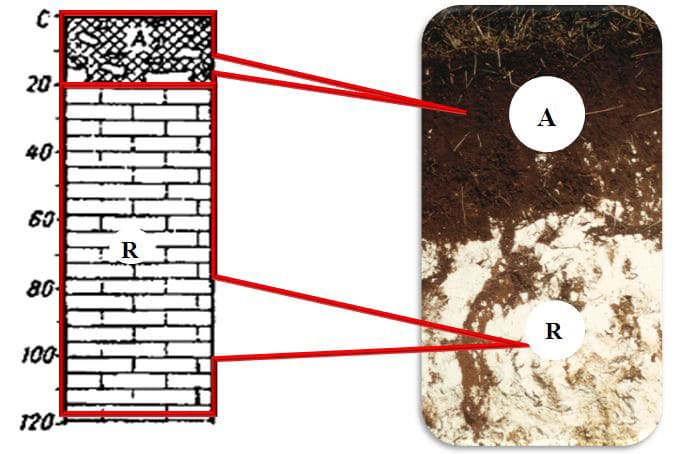
2) Immature profile with complete set of genetic horizons specific for this soil type, but with short-cut or thin horizons;

3) Normal profile with complete set of genetic horizons specific for this soil type and with specific for non-eroded flat plain soils thickness of each horizon;
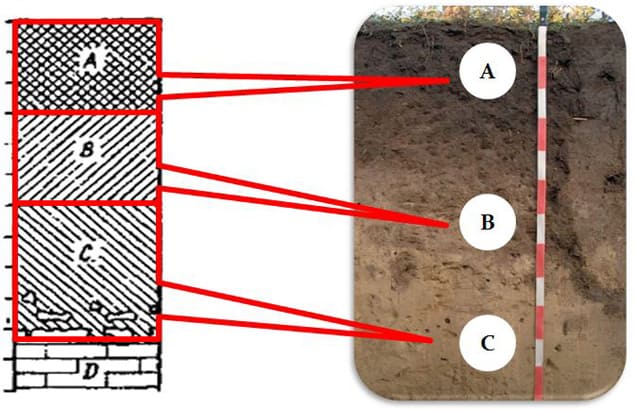
4) Poorly differentiated profile with hardly distinguished and gradually changed horizons;
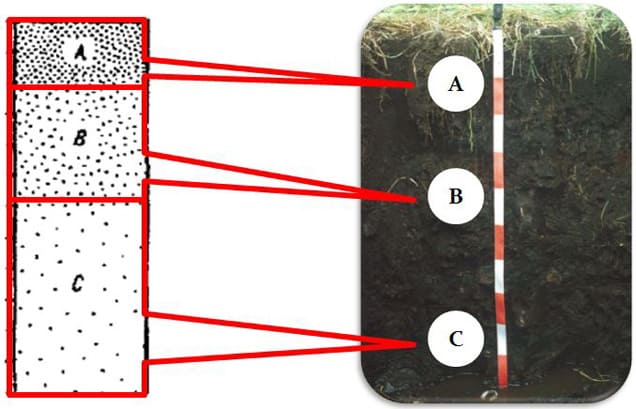
5) Disturbed (eroded) profile with upper horizons destroyed by the erosion.
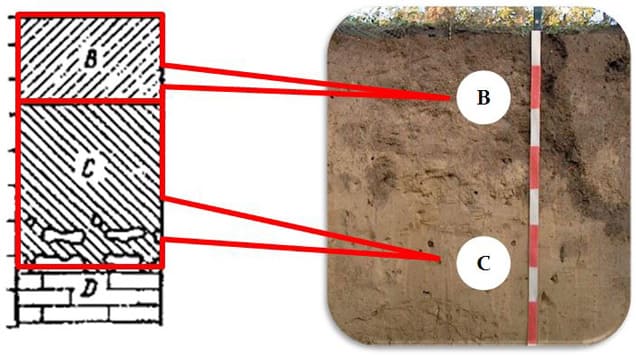
Complicated types of soil profiles are:
1) Relict profile contains buried horizons or buried palaeo-soil profiles; or, on the other side it contains non-buried relict horizons with traces of ancient soil-forming process;
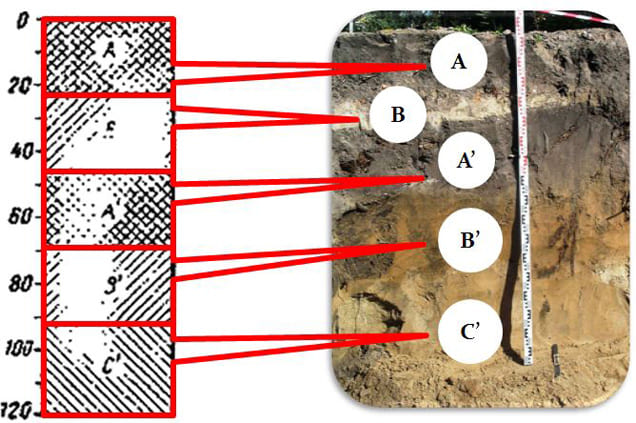
2) Polynomial profile is forming as a result of lithologic change within soil stratum;

3) Polycyclic profile is a result of reccurent deposits of soil-forming material i.e. river and eolian alluvium, volcanic ash etc;

4) Disturbed (reverse) profile with shifted to the surface lower horizons (by human or natural (e.g. windfall in the forest) activity;
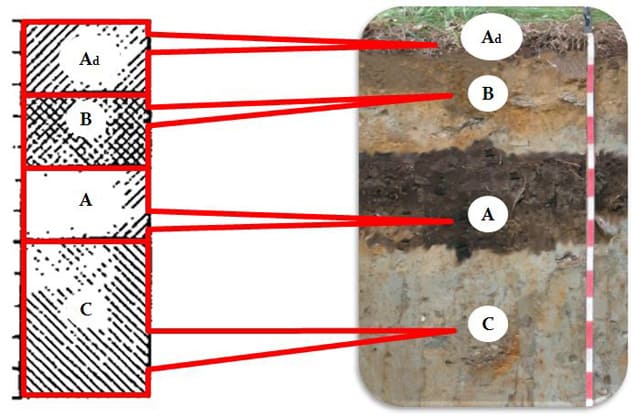
5) Mottled (mosaic) profile with genetic horizons changing each other on a small extent not in vertical order of horizontal layers but in mosaic.

Classification of soil profile types mentioned above is based on the correlation of genetic soil horizons. Another classification of soil profile types is based on the analysis of vertical distribution of chemical substances in the profile. In the basis of such classification can be both single substance or substance group (such as humus, lime, gypsum, water-soluble salts, clay minerals, sesquioxides etc) and aggregate of pedochemically connected substances. Vertical distribution reflects in soil morphology e.g. in soil colouring, solidity, in character and distribution of soil concentrations. In accordance with such classification there are following types of soil profiles:
1) Accumulative profile with the maximum accumulation of certain substances from the surface and their gradual fall with depth. The distribution curve of the substance, for example humus, may be regressive-accumulative (concave), progressive-accumulative (convex) or uniformly accumulative;
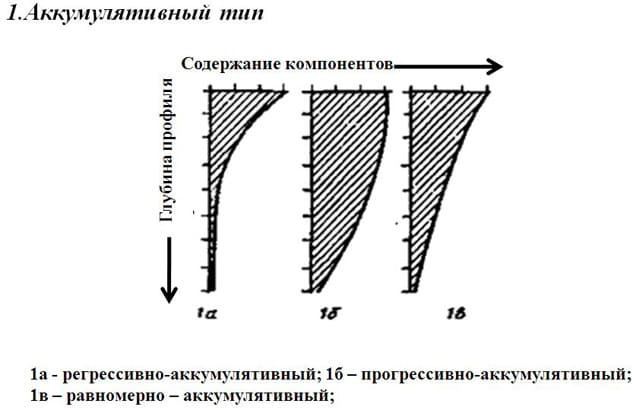
2) Eluvial profile with the minimum of certain substances on the surface and their gradual increase with depth. The distribution curve of the substance, for example calcium carbonate, may be regressive-eluvial (concave), progressive-eluvial (convex) or uniformly eluvial;
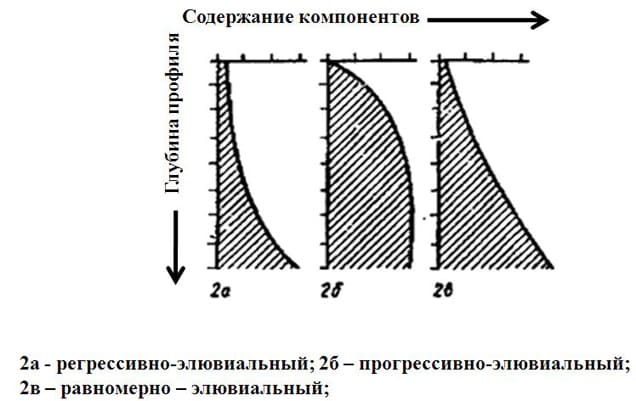
3) Groundwater- accumulative profile with accumulation of substances from groundwater in the lower and middle part of the profile;
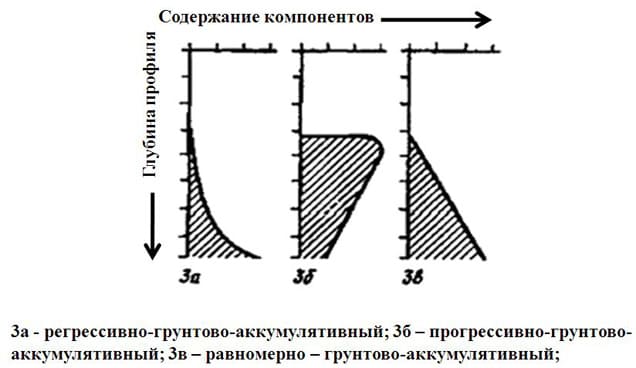
4) Eluvial-illuvial profile with the minimum of substances in the upper part of profile and the maximum in the middle and lower part of profile;
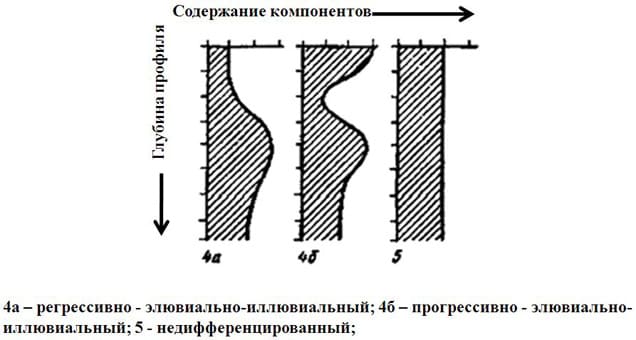
5) Undifferentiated profile with a uniform content of the substance throughout the soil thickness.
All morphological soil characteristics are divided into three groups by academician B.B.Polynov:
- Peculiar and determinative for the single horizon;
- Dispersed through the whole profile;
- Peculiar for the part of soil profile which is not equal to the main genetic horizons.
All morphological soil characteristics can also be divided into two groups – horizontal (e.g. color) and non-horizontal (e.g. cracking). Academician B.B.Polynov supposes that the division is connected with independent particular processes within soil forming process provided different vertical distribution of chemical substances in the profile. The horizon shaped by one process can be non-coincident to the horizon shaped by another process. E.g. humus-accumulative horizon is non-equal to calcareous-accumulative horizon. As a result different distribution profiles for different substances can be found in one soil. E.g. sod-podzolic soil combines regressive-accumulative profile for humus, eluvial-illuvial profile for сlay minerals and sesquioxides, eluvial profile for alkali and alkali earth elements.
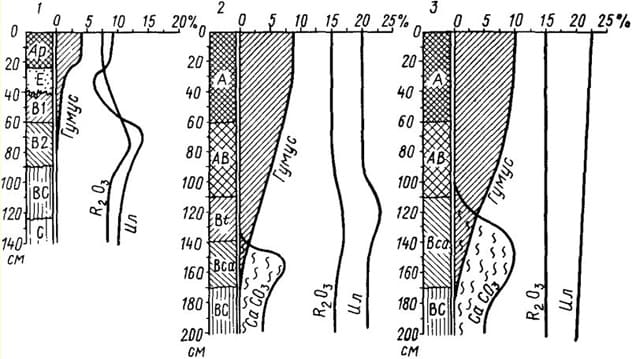
Not numerous genetic soil profiles (integral names) that is a combination of mentioned above soil profile types and distribution of substances types can be distinguished for definite soil forming processes, e.g.:
- Undifferentiated (primitive) profile, typical for initial stages of soil forming process or for soils on sands. There are only A and C horizons or rudiments of other horizons which can be hardly divided in the parent rock.
- Isohumic profile with well-defined from the surface humus accumulation and its gradual fall with depth, possible differentiation of water soluble salts, gypsum and carbonates and no differentiation of more stable substances (сlay minerals, O3, SiO2, basic minerals); humus horizon with large thickness
- Metamorphic profile with poor or strong differentiation of clay, with clay-covering process in the whole profile or in its part and without eluvial-illuvial redistribution of substances especially clays
- Eluvial-illuvial -differentiated (texture-differentiated ) profile with well-defined eluvial and corresponding illuvial horizons.
- Hydrogenic-differentiated profile with accumulation of some substances (commonly salts, gypsum, calcium carbonate, ferrum hydroxides, SiO) in definite part of the profile and shaped as a result of hidrogenic accumulation in conditions of ancient or modern hydromorphism.
- Cryogenic-differentiated profile shaped as a result of presence of subsurface permafrost layer.
- Anthropogenic- differentiated (artificial ) profile shaped by human, e.g. as a result of deep ploughing, reclamation of disturbed soils, soil transplantation on stony slopes, artificial raising of lowlands with following drainage.